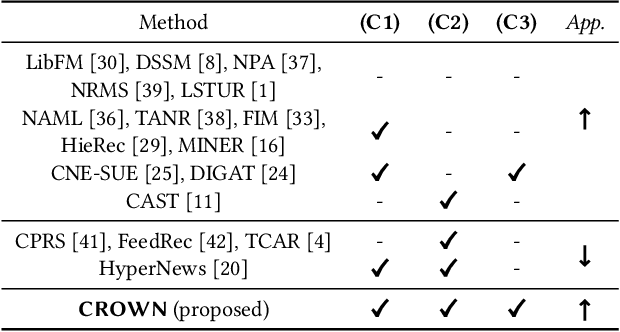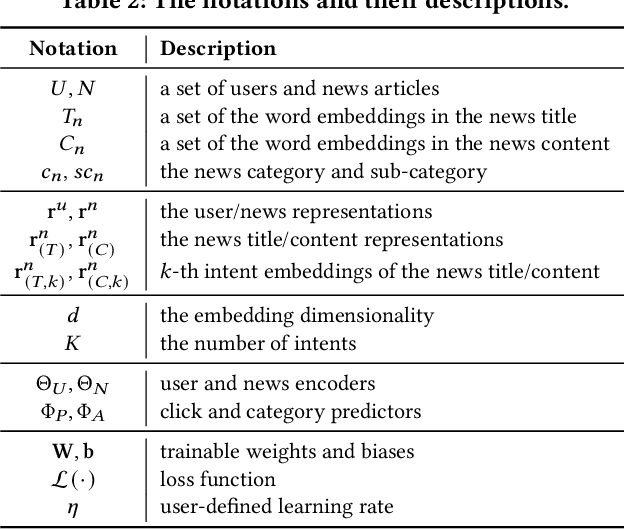Yunyong Ko
HyGEN: Regularizing Negative Hyperedge Generation for Accurate Hyperedge Prediction
Feb 09, 2025



Abstract:Hyperedge prediction is a fundamental task to predict future high-order relations based on the observed network structure. Existing hyperedge prediction methods, however, suffer from the data sparsity problem. To alleviate this problem, negative sampling methods can be used, which leverage non-existing hyperedges as contrastive information for model training. However, the following important challenges have been rarely studied: (C1) lack of guidance for generating negatives and (C2) possibility of producing false negatives. To address them, we propose a novel hyperedge prediction method, HyGEN, that employs (1) a negative hyperedge generator that employs positive hyperedges as a guidance to generate more realistic ones and (2) a regularization term that prevents the generated hyperedges from being false negatives. Extensive experiments on six real-world hypergraphs reveal that HyGEN consistently outperforms four state-of-the-art hyperedge prediction methods.
HearHere: Mitigating Echo Chambers in News Consumption through an AI-based Web System
Feb 29, 2024Abstract:Considerable efforts are currently underway to mitigate the negative impacts of echo chambers, such as increased susceptibility to fake news and resistance towards accepting scientific evidence. Prior research has presented the development of computer systems that support the consumption of news information from diverse political perspectives to mitigate the echo chamber effect. However, existing studies still lack the ability to effectively support the key processes of news information consumption and quantitatively identify a political stance towards the information. In this paper, we present HearHere, an AI-based web system designed to help users accommodate information and opinions from diverse perspectives. HearHere facilitates the key processes of news information consumption through two visualizations. Visualization 1 provides political news with quantitative political stance information, derived from our graph-based political classification model, and users can experience diverse perspectives (Hear). Visualization 2 allows users to express their opinions on specific political issues in a comment form and observe the position of their own opinions relative to pro-liberal and pro-conservative comments presented on a map interface (Here). Through a user study with 94 participants, we demonstrate the feasibility of HearHere in supporting the consumption of information from various perspectives. Our findings highlight the importance of providing political stance information and quantifying users' political status as a means to mitigate political polarization. In addition, we propose design implications for system development, including the consideration of demographics such as political interest and providing users with initiatives.
CIDER: Category-Guided Intent Disentanglement for Accurate Personalized News Recommendation
Oct 13, 2023



Abstract:Personalized news recommendation aims to assist users in finding news articles that align with their interests, which plays a pivotal role in mitigating users' information overload problem. Although many recent works have been studied for better user and news representations, the following challenges have been rarely studied: (C1) How to precisely comprehend a range of intents coupled within a news article? and (C2) How to differentiate news articles with varying post-read preferences in users' click history? To tackle both challenges together, in this paper, we propose a novel personalized news recommendation framework (CIDER) that employs (1) category-guided intent disentanglement for (C1) and (2) consistency-based news representation for (C2). Furthermore, we incorporate a category prediction into the training process of CIDER as an auxiliary task, which provides supplementary supervisory signals to enhance intent disentanglement. Extensive experiments on two real-world datasets reveal that (1) CIDER provides consistent performance improvements over seven state-of-the-art news recommendation methods and (2) the proposed strategies significantly improve the model accuracy of CIDER.
Enhancing Hyperedge Prediction with Context-Aware Self-Supervised Learning
Sep 11, 2023



Abstract:Hypergraphs can naturally model group-wise relations (e.g., a group of users who co-purchase an item) as hyperedges. Hyperedge prediction is to predict future or unobserved hyperedges, which is a fundamental task in many real-world applications (e.g., group recommendation). Despite the recent breakthrough of hyperedge prediction methods, the following challenges have been rarely studied: (C1) How to aggregate the nodes in each hyperedge candidate for accurate hyperedge prediction? and (C2) How to mitigate the inherent data sparsity problem in hyperedge prediction? To tackle both challenges together, in this paper, we propose a novel hyperedge prediction framework (CASH) that employs (1) context-aware node aggregation to precisely capture complex relations among nodes in each hyperedge for (C1) and (2) self-supervised contrastive learning in the context of hyperedge prediction to enhance hypergraph representations for (C2). Furthermore, as for (C2), we propose a hyperedge-aware augmentation method to fully exploit the latent semantics behind the original hypergraph and consider both node-level and group-level contrasts (i.e., dual contrasts) for better node and hyperedge representations. Extensive experiments on six real-world hypergraphs reveal that CASH consistently outperforms all competing methods in terms of the accuracy in hyperedge prediction and each of the proposed strategies is effective in improving the model accuracy of CASH. For the detailed information of CASH, we provide the code and datasets at: https://github.com/yy-ko/cash.
KHAN: Knowledge-Aware Hierarchical Attention Networks for Accurate Political Stance Prediction
Mar 01, 2023



Abstract:The political stance prediction for news articles has been widely studied to mitigate the echo chamber effect -- people fall into their thoughts and reinforce their pre-existing beliefs. The previous works for the political stance problem focus on (1) identifying political factors that could reflect the political stance of a news article and (2) capturing those factors effectively. Despite their empirical successes, they are not sufficiently justified in terms of how effective their identified factors are in the political stance prediction. Motivated by this, in this work, we conduct a user study to investigate important factors in political stance prediction, and observe that the context and tone of a news article (implicit) and external knowledge for real-world entities appearing in the article (explicit) are important in determining its political stance. Based on this observation, we propose a novel knowledge-aware approach to political stance prediction (KHAN), employing (1) hierarchical attention networks (HAN) to learn the relationships among words and sentences in three different levels and (2) knowledge encoding (KE) to incorporate external knowledge for real-world entities into the process of political stance prediction. Also, to take into account the subtle and important difference between opposite political stances, we build two independent political knowledge graphs (KG) (i.e., KG-lib and KG-con) by ourselves and learn to fuse the different political knowledge. Through extensive evaluations on three real-world datasets, we demonstrate the superiority of DASH in terms of (1) accuracy, (2) efficiency, and (3) effectiveness.
 Add to Chrome
Add to Chrome Add to Firefox
Add to Firefox Add to Edge
Add to Edge